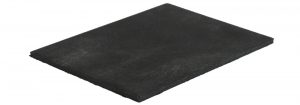CR seals
CR stands for chloroprene rubber, a synthetic rubber and belongs to the elastomers of the R group, which are characterised by an unsaturated hydrocarbon chain. Probably the best-known trade name is Neoprene® In addition, the material is also traded as Baypren®.

Available CR materials at Rehm Dichtungen Ehlers GmbH
We obtain most of our sealing material from the manufacturer Semperit in the form of rolls and sheets. Here we divide the material qualities into three ranges that are suitable for different applications.
Semperit quality
N9581 CR/SBR
Technical data sheet:
Properties:
| Hardness [Shore A] | ISO 7619-1 | 65 +-5 |
| Density [g/cm³] | ISO 1183 | Approx. 1.40 |
| Tensile strength [N/mm²] | ISO 37-S2 | 6 |
| Elongation at break [%] | ISO 37-S2 | 200 |
Approvals and certifications:
- Corresponds to WDK guideline 2201
- SVHC-free
Import qualities
CR/SBR 65 Shore
Technical data sheet:
Properties:
| Hardness [Shore A] | ISO 7619-1 | 65 +-10 |
| Density [g/cm³] | ISO 1183 | Approx. 1.4 |
| Tensile strength [N/mm²] | ISO 37-S2 | 4 |
| Elongation at break [%] | ISO 37-S2 | 250 |
CR/SBR 65 Shore with insert
Technical data sheet:
Properties:
| Hardness [Shore A] | ISO 7619-1 | 65 +-10 |
| Density [g/cm³] | ISO 1183 | Approx. 1.4 |
| Tensile strength [N/mm²] | ISO 37-S2 | 4 |
| Elongation at break [%] | ISO 37-S2 | 250 |
CR/SBR light 65 Shore
Technical data sheet:
Properties:
| Hardness [Shore A] | ISO 7619-1 | 65 +-10 |
| Density [g/cm³] | ISO 1183 | Approx. 1.5 |
| Tensile strength [N/mm²] | ISO 37-S2 | 5 |
| Elongation at break [%] | ISO 37-S2 | 300 |
The properties of CR as a sealing material
Chloroprene is produced by polymerising 2-chloro-1,3-butadiene. During the process, acid is added to the resulting dispersion, which is then cooled and dried.
The chlorine atoms in the material are inert, which makes the rubber stable. Furthermore, the vulcanised chloroprene has good mechanical and chemical properties. The material is resistant to embrittlement, ozone and weathering. The synthetic rubber shows good swelling resistance in mineral oils with an aniline point, in greases, many refrigerants and in water. CR is moderately resistant to swelling in mineral oils and low-molecular aliphatic hydrocarbons. In aromatics, the material is strongly swelling. Chloroprene is temperature-resistant in the temperature range -20° C and +120° C. The concrete specifications vary depending on the composition of the compound.
The advantages of CR at a glance
Chloroprene is characterised by a number of properties that make the material suitable for many applications. It is:
- Resistant to: Embrittlement, ozone and weathering influences
- Good swelling resistance to: mineral, vegetable and animal fats as well as mineral oils with a high aniline point, many refrigerants and water
- strongly swelling in: Aromatics such as benzene, esters, ketones and chlorinated hydrocarbons.
- Resistant to: dilute acids and salt solutions
- flame-retardant
Furthermore, the elastomer has very good dynamic properties. The electrical insulating properties of polychloroprene are worse than those of NR, which is due to the polarity. Certain fillers increase the insulating properties. CR can therefore be used in the low-voltage range.
The sealing material cannot be cross-linked with sulphur, has only limited oil resistance and is not resistant to fuels or aromatic oils.
CR Resilience at a glance
| Material designation | Ozone and weather resistance | Oil and petrol resistance | Acid resistance | Strong bases | Wear resistance |
|---|---|---|---|---|---|
| Semperit N 9581 | conditionally stable | not durable | conditionally stable | conditionally stable | Not suitable |
Areas of application for CR seals
The material is used in various areas. Due to its slow crystallisation, CR is particularly used for seals in the automotive and other industries. Various seals made of this material are also used in air conditioning and medical technology. The shipping industry is also an important customer for this material, as it does not lose its function when it comes into contact with seawater.
We will be happy to answer your questions about whether CR is suitable as a sealing material for your purposes. Please contact our customer service, who will be happy to provide you with comprehensive advice.

